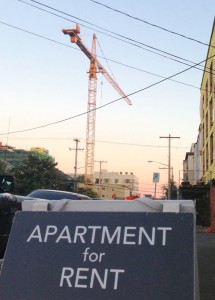Seattle Times: Fewer Rules, More Housing
 Affordability is a relationship to price, a relationship that is conditioned by a person’s income and expenses. This dependence on income and expenses is just as true for food as it is for housing and other of life’s essentials; the less money we earn, the more money we spend, the more expensive and less affordable life becomes.
Affordability is a relationship to price, a relationship that is conditioned by a person’s income and expenses. This dependence on income and expenses is just as true for food as it is for housing and other of life’s essentials; the less money we earn, the more money we spend, the more expensive and less affordable life becomes.
A recent Seattle Times editorial shows a promising change in the language being used to talk about housing affordability in Seattle. The editorial links housing supply and the costs associated with building housing with higher prices. Basic economics for housing or any other product dictates that increases in supply when demand is constant can result in lower prices. Higher production costs don’t help with price either. So the Times Editorial board is starting to get it:
The City Council can streamline the permitting process and change zoning laws to create incentives for developers.
And
Construction of affordable housing has not kept up with demand. Rent surged by 3 percent citywide within the past three months alone, while vacancy rates dropped to 4.41 percent from 4.83 percent a year ago, according to Apartment Insights. The average rent increased from $1,155 to $1,190 per unit. In the Capitol Hill neighborhood, rents soared 8.2 percent to $1,395 each month.
These things are true. If the Council made a serious effort to relax requirements on new housing construction (and create real incentives for building housing not taxes on new housing) we’d get more housing, enough to keep up with growing demand created by an economy that is creating more jobs and more growth in our city.
This, if combined with more financial help for people at the lowest levels of income in our city, would begin to substantively affect housing price and people’s relationship to price, opening more opportunities for people to live and work in Seattle. But how do we get there?
The first and most important step is to aggressively but wisely deregulate the housing market in areas of our city that can most effectively absorb new growth with transportation infrastructure; that means more growth in areas already zoned for density with easy transit access.
A review of the costs of affordable housing developments in Washington found that
affordable housing projects are sometimes subject to additional requirements at the local level that add to their development cost. Local jurisdictions may require a project to include certain elements, such as structured parking, or to contribute to development of off-site infrastructure, such as water and sewer line extensions, street improvements, sidewalks, and street lights.
There are too many rules that add to the time and cost of building housing whether the project is built by for profit or non-profit housing developer.
Second, if innovation is encouraged new housing solutions like microhousing and small-lot development can meet the need for what has often been called “workforce housing;” that is housing that is priced affordably for people who earn around 60 to 80 percent of Area Median Income (AMI), about $50,000 per year or $1,200 per month for housing.
Microhousing easily meets this demand in the housing market, producing units that are priced, often, well below the high end of the workforce housing AMI. Many of the residents of microhousing earn significantly less than 60 percent of AMI, but choose to live in microhousing because while they might be spending more than 30 percent of their monthly income of rent, their other costs for things like transportation are far lower.
If developers are allowed to innovate, producing lots more housing, market prices will fall; they might even fall enough to meet the needs of people who earn 60 percent of AMI or less, levels of income that potentially qualify for housing assistance. Thinks about that for a moment: if the market produces housing affordable for people at 50 percent of AMI, that would mean precious public dollars could be concentrated on people who earn 40 or 30 percent of AMI.
Some levels of income will always require a subsidy for housing, but lowering overall housing prices, decreasing transportation costs, increasing wages, lowering health care costs can all contribute to making the city more affordable. This is particularly true for the group the Times describes as being the most in need, “someone who earns the minimum wage of $9.04 per hour and can afford only $470 per month on rent.”
The way we make life easier for the hardest working but lowest paid people in our economy is to let housing supply and choice grow while maintaining healthy housing assistance programs. If we combine increases in wages, lowered costs of living, and lower housing price through increases in supply the goal of a “rich socioeconomic, ethnic and cultural diversity” is truly achievable in Seattle.


